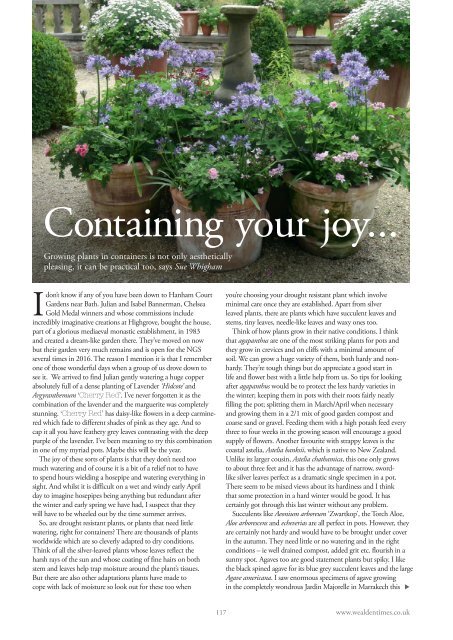Surrey Homes | SH19 | May 2016 | Restoration & New Build supplement inside
The lifestyle magazine for Surrey - Inspiring Interiors, Fabulous Fashion, Delicious Dishes
The lifestyle magazine for Surrey - Inspiring Interiors, Fabulous Fashion, Delicious Dishes
You also want an ePaper? Increase the reach of your titles
YUMPU automatically turns print PDFs into web optimized ePapers that Google loves.
Containing your joy...<br />
Growing plants in containers is not only aesthetically<br />
pleasing, it can be practical too, says Sue Whigham<br />
I<br />
don’t know if any of you have been down to Hanham Court<br />
Gardens near Bath. Julian and Isabel Bannerman, Chelsea<br />
Gold Medal winners and whose commissions include<br />
incredibly imaginative creations at Highgrove, bought the house,<br />
part of a glorious mediaeval monastic establishment, in 1983<br />
and created a dream-like garden there. They’ve moved on now<br />
but their garden very much remains and is open for the NGS<br />
several times in <strong>2016</strong>. The reason I mention it is that I remember<br />
one of those wonderful days when a group of us drove down to<br />
see it. We arrived to find Julian gently watering a huge copper<br />
absolutely full of a dense planting of Lavender ‘Hidcote’ and<br />
Argyranthemum ‘Cherry Red’. I’ve never forgotten it as the<br />
combination of the lavender and the marguerite was completely<br />
stunning. ‘Cherry Red’ has daisy-like flowers in a deep carminered<br />
which fade to different shades of pink as they age. And to<br />
cap it all you have feathery grey leaves contrasting with the deep<br />
purple of the lavender. I’ve been meaning to try this combination<br />
in one of my myriad pots. <strong>May</strong>be this will be the year.<br />
The joy of these sorts of plants is that they don’t need too<br />
much watering and of course it is a bit of a relief not to have<br />
to spend hours wielding a hosepipe and watering everything in<br />
sight. And whilst it is difficult on a wet and windy early April<br />
day to imagine hosepipes being anything but redundant after<br />
the winter and early spring we have had, I suspect that they<br />
will have to be wheeled out by the time summer arrives.<br />
So, are drought resistant plants, or plants that need little<br />
watering, right for containers? There are thousands of plants<br />
worldwide which are so cleverly adapted to dry conditions.<br />
Think of all the silver-leaved plants whose leaves reflect the<br />
harsh rays of the sun and whose coating of fine hairs on both<br />
stem and leaves help trap moisture around the plant’s tissues.<br />
But there are also other adaptations plants have made to<br />
cope with lack of moisture so look out for these too when<br />
you’re choosing your drought resistant plant which involve<br />
minimal care once they are established. Apart from silver<br />
leaved plants, there are plants which have succulent leaves and<br />
stems, tiny leaves, needle-like leaves and waxy ones too.<br />
Think of how plants grow in their native conditions. I think<br />
that agapanthus are one of the most striking plants for pots and<br />
they grow in crevices and on cliffs with a minimal amount of<br />
soil. We can grow a huge variety of them, both hardy and nonhardy.<br />
They’re tough things but do appreciate a good start in<br />
life and flower best with a little help from us. So tips for looking<br />
after agapanthus would be to protect the less hardy varieties in<br />
the winter; keeping them in pots with their roots fairly neatly<br />
filling the pot; splitting them in March/April when necessary<br />
and growing them in a 2/1 mix of good garden compost and<br />
coarse sand or gravel. Feeding them with a high potash feed every<br />
three to four weeks in the growing season will encourage a good<br />
supply of flowers. Another favourite with strappy leaves is the<br />
coastal astelia, Astelia banksii, which is native to <strong>New</strong> Zealand.<br />
Unlike its larger cousin, Astelia chathamica, this one only grows<br />
to about three feet and it has the advantage of narrow, swordlike<br />
silver leaves perfect as a dramatic single specimen in a pot.<br />
There seem to be mixed views about its hardiness and I think<br />
that some protection in a hard winter would be good. It has<br />
certainly got through this last winter without any problem.<br />
Succulents like Aeonium arboreum ‘Zwartkop’, the Torch Aloe,<br />
Aloe arborescens and echeverias are all perfect in pots. However, they<br />
are certainly not hardy and would have to be brought under cover<br />
in the autumn. They need little or no watering and in the right<br />
conditions – ie well drained compost, added grit etc. flourish in a<br />
sunny spot. Agaves too are good statement plants but spiky. I like<br />
the black spined agave for its blue grey succulent leaves and the large<br />
Agave americana. I saw enormous specimens of agave growing<br />
in the completely wondrous Jardin Majorelle in Marrakech this <br />
117 www.wealdentimes.co.uk


















